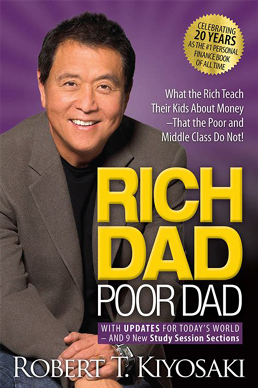RICH DAD POOR DAD, SYNOPSIS

“Rich Dad Poor Dad” by Robert Kiyosaki is a personal finance and self-help book that challenges conventional beliefs about money and provides insights into building wealth. Here is a detailed synopsis of the book:
Part One: Rich Dad, Poor Dad
- Rich Dad, Poor Dad: Kiyosaki introduces his two influential figures in his life: his “poor dad” (his biological father, who was highly educated but struggled financially) and his “rich dad” (his best friend’s father, who was a successful entrepreneur). Through their contrasting beliefs and financial practices, Kiyosaki highlights the importance of financial education and mindset.
- The Rich Don’t Work for Money: Kiyosaki emphasizes the need to shift from an employee mindset to a mindset focused on building assets and creating passive income streams. He explains the concept of working to learn rather than working for a paycheck.
- Why Teach Financial Literacy? Kiyosaki highlights the lack of financial education in traditional schooling and advocates for individuals to take control of their financial education by seeking knowledge about money management, investing, and building wealth.
Part Two: The Rich Don’t Work for Money
- Mind Your Own Business: Kiyosaki encourages readers to start thinking like entrepreneurs by minding their own businesses. He emphasizes the importance of understanding financial statements and analyzing investments.
- The History of Taxes and the Power of Corporations: Kiyosaki explores the impact of taxes on individuals and highlights the tax advantages available to business owners and investors. He explains the power of incorporating and using legal entities to minimize taxes and protect assets.
- The Rich Invent Money: Kiyosaki discusses the importance of financial creativity and finding opportunities to create wealth. He encourages readers to develop their financial intelligence to identify and capitalize on investment opportunities.
- Work to Learn – Don’t Work for Money: Kiyosaki emphasizes the value of continuous learning and acquiring new skills. He encourages readers to invest in their own personal and professional development.
Part Three: Mind Your Own Business
- Overcoming Obstacles: Kiyosaki addresses common fears and limiting beliefs about money and provides strategies for overcoming them. He emphasizes the importance of taking calculated risks and embracing failures as learning opportunities.
- Getting Started: Kiyosaki outlines practical steps to begin the journey towards financial independence, including setting financial goals, building a team of advisors, and developing an investment plan.
- Still Want More? Here Are Some To Do’s: Kiyosaki concludes the book with a list of recommended actions and resources for readers to further their financial education and embark on their path to financial freedom.
“Rich Dad Poor Dad” challenges traditional notions about money, work, and education. It emphasizes the importance of financial literacy, mindset, and taking control of one’s financial destiny. By sharing personal stories and practical advice, Kiyosaki aims to inspire readers to adopt a wealth-building mindset and make informed financial decisions. The book encourages individuals to think outside the box, leverage opportunities, and develop financial intelligence to achieve financial independence.
Short biography of Robert Kiyosaki
Robert Kiyosaki is an American entrepreneur, investor, motivational speaker, and author best known for his popular book series, “Rich Dad Poor Dad.” He was born on April 8, 1947, in Hilo, Hawaii.
Kiyosaki’s childhood was influenced by two significant figures in his life: his “poor dad” (his biological father, a highly educated government employee) and his “rich dad” (his best friend’s father, an entrepreneur). The contrasting financial philosophies of these two individuals played a pivotal role in shaping Kiyosaki’s views on money and wealth.
After completing his education, Kiyosaki served as a helicopter gunship pilot in the Vietnam War. Following his military service, he started his entrepreneurial journey by establishing various businesses, including a wallet manufacturing company and a rock-and-roll business. However, these ventures faced challenges and eventually led him into financial difficulties.
Kiyosaki’s breakthrough came with the publication of his book “Rich Dad Poor Dad” in 1997. The book became an international bestseller, selling millions of copies worldwide. It presented his personal experiences and the financial lessons he learned from his two dads, offering insights into building wealth and achieving financial independence.
Inspired by the success of “Rich Dad Poor Dad,” Kiyosaki continued to write and publish numerous books focusing on personal finance, investing, and entrepreneurship. Some of his other notable works include “Cashflow Quadrant,” “Rich Dad’s Guide to Investing,” and “Rich Dad’s CASHFLOW Quadrant.”
Apart from being an author, Kiyosaki is an active investor and real estate entrepreneur. He conducts seminars and workshops worldwide, where he shares his knowledge and insights on wealth creation and financial education. His teachings emphasize the importance of financial intelligence, investing in assets, and developing a mindset conducive to wealth creation.
Throughout his career, Robert Kiyosaki has been a controversial figure, attracting both praise and criticism for his financial advice and perspectives. Nevertheless, his books and teachings have had a significant impact on individuals seeking to gain financial literacy and take control of their financial future.
Robert Kiyosaki’s contributions in the field of personal finance have made him a prominent figure in the realm of financial education, inspiring millions of people around the world to strive for financial independence and pursue their entrepreneurial aspirations.
